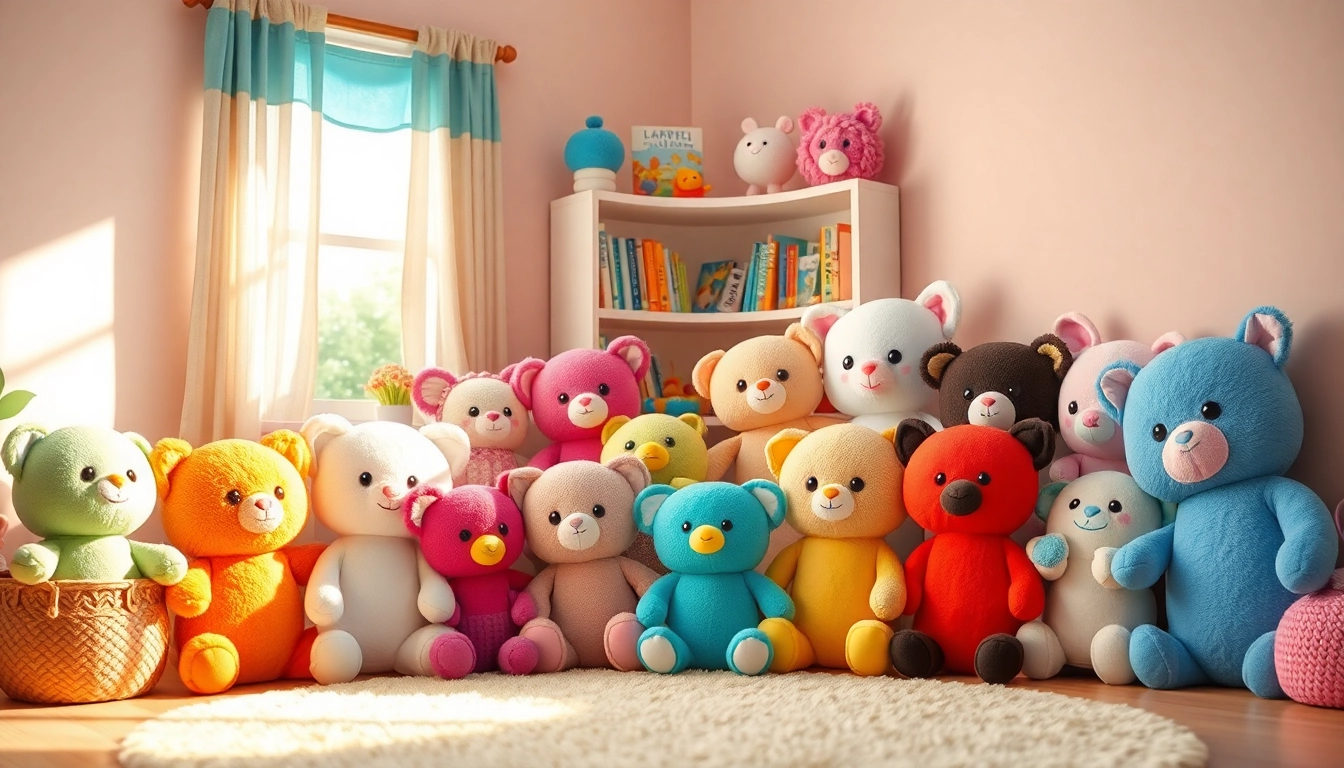Ultimate Guide to Custom Plushies: 7 Tips for Creating Unique Toys

Understanding Custom Plushies
What are Custom Plushies?
Custom plushies are unique stuffed animals or dolls that are designed based on specific customer requirements. Unlike mass-produced plush toys, custom plushies encompass a broader range of creativity and personalization. They can be crafted to resemble original characters, beloved pets, or even imaginative designs dreamt up by individuals or brands. This distinctive quality caters to a variety of emotions, making custom plushies perfect for gifts, promotional products, or personal keepsakes. For those interested in exploring options for creating custom plushies, custom plushies offer a versatile range of possibilities.
The History of Plush Toy Manufacturing
The journey of plush toys began in the early 19th century, with the creation of simple stuffed animals made from fabric scraps. The first notable plush toy, “Teddy Bear,” emerged in the early 1900s and forever changed the landscape of toys available to children. Initial manufacturing was largely handmade, which limited the variety available to consumers. As industrialization progressed, the manufacturing of plush toys transitioned into factories, greatly increasing output and variety.
The late 20th century witnessed a surge in the popularity of custom plush toys, driven by the rise of the internet and digital printing technologies. This advancement allowed customers to commission unique designs that reflected personal stories or branding, merging creativity with technology to bring imagination to life. Today, custom plush manufacturing has become an art form, catering to an array of needs across different demographics.
Common Uses for Custom Plushies
Custom plushies serve various purposes across different sectors. One of the most popular uses is for personalized gifts, ideal for birthdays, weddings, or other special occasions. Businesses also leverage custom plush toys as marketing merchandise to enhance brand recognition. These toys can act as memorable giveaways at events or exhibitions, fostering a connection with clients and influencing purchasing decisions.
Additionally, custom plushies can be utilized in educational settings, aiding in engagement and storytelling for children. Nonprofits and charities often create plush toys as part of fundraising or awareness campaigns, using them to connect emotionally with potential donors.
Designing Your Perfect Custom Plushie
Choosing the Right Materials
The choice of materials is crucial when designing custom plushies. Fabric types range from soft fleece to luxurious minky, each providing a different tactile experience. Eco-friendly materials are gaining popularity due to increased consciousness about sustainability, leading many manufacturers to offer organic or recycled fabric options.
Filling materials also significantly impact the plushie’s feel. Common fillings include polyester fiberfill and natural materials like wool or cotton. The desired durability, softness, and intended use will inform this choice. For instance, plushies intended for children may require hypoallergenic and washable materials, ensuring safety and hygiene.
Incorporating Unique Features
Designing a custom plushie allows for many unique features to be included, which can enhance its appeal. Adding personalized elements like embroidery, custom colors, and even sound or interactive components can significantly elevate the plushie’s desirability. These features should reflect the personality or character that the plushie aims to portray.
Additionally, integrating practical elements such as removable clothing or accessories can also attract certain consumer segments. These unique features not only bolster visual interest but also encourage creative play among children and collectors alike.
Design Inspirations for Custom Plushies
Draw inspiration from various sources when conceptualizing your custom plushies. Popular culture, including movies, cartoons, and video games, can spark ideas, while personal experiences and anecdotes can lead to more meaningful designs. Art styles like minimalist, cartoonish, or realistic influences can guide the aesthetic appeal of the plush toy.
Nature is also an abundant source of inspiration, with animal forms providing countless opportunities to create unique plushies. For those lacking artistic direction, collaborating with a professional designer can present an effective way to turn abstract ideas into visual concepts.
Production Process for Custom Plushies
From Concept to Prototype
The production process of custom plushies begins with concept development, where initial ideas are sketched and refined. Designers may use digital tools to create detailed representations, ensuring precise interpretation of the envisioned final product. This phase often involves collaboration between the client and designers to align expectations and feasibility.
Once a concept is finalized, a prototype is produced. This prototype serves as a tangible representation of the design, allowing for adjustments in size, proportions, and features. Testing the prototype ensures that the quality, durability, and aesthetic appeal meet the desired standards before mass production begins.
Working with Manufacturers
Selecting the right manufacturer is critical to the success of custom plushie projects. Factors to consider include the manufacturer’s experience, quality control processes, and capacity for customization. Communication is also vital; ensuring that the manufacturer understands the specific requirements of the custom plushies helps avoid misunderstandings that could lead to delays or unsatisfactory products.
Establishing a strong partnership with the manufacturer can streamline logistics and production schedules. It’s beneficial to request samples and references to gauge a potential partner’s reliability and quality before committing to an order.
Quality Assurance Steps
Quality assurance is a key component of custom plushie production. Implementing inspection protocols at various stages—during the prototype phase, before mass production, and upon completion—can prevent defects and ensure consistency in the final products. Standards such as safety compliance, durability testing, and sensory evaluation are essential to create plushies that are not only visually appealing but also safe and long-lasting.
Additionally, feedback from consumer testing can provide qualitative data that informs improvements for future production runs. Addressing issues early reduces the potential for costly recalls or brand reputation damage.
Marketing and Selling Custom Plushies
Identifying Your Target Audience
Knowing your target audience is essential when marketing custom plushies. Demographics such as age, interests, and spending power play significant roles in shaping product ideas and marketing strategies. For instance, plushies directed at younger audiences may focus on playful themes and bright colors, while adult collectors might gravitate towards sophisticated designs.
Conducting thorough market research and gathering consumer feedback can unveil insights into preferences, allowing for a tailored approach to product development and marketing. Segmenting your audience can also help in creating targeted marketing campaigns that resonate better with specific groups.
Online Platforms for Selling Custom Plushies
In today’s digital landscape, various online platforms facilitate the sale of custom plushies. E-commerce sites such as Etsy, personalized product marketplaces, and standalone websites allow businesses to showcase their unique offerings. Each platform comes with its own audience; hence, selecting the right one is crucial for maximizing visibility and sales.
Social media platforms, particularly visually-driven ones like Instagram and Pinterest, can serve as effective marketing tools. Regularly engaging with followers through content that showcases the lifestyle associated with custom plushies can promote sales while fostering a community around the brand.
Effective Marketing Strategies
Implementing effective marketing strategies is vital for successful sales of custom plushies. Content marketing, including blog posts and videos that tell the story behind the plushies, can create emotional connections with customers. Collaborating with influencers or brand ambassadors in relevant niches can also promote products to wider audiences.
Utilizing paid advertising can further enhance the visibility of custom plushies, particularly when targeted towards audiences who have shown an interest in similar products. Offering limited-time promotions or exclusive designs can create a sense of urgency, encouraging customers to make purchases quickly.
Common Challenges in Custom Plushies Production
Managing Costs and Budget
Effective budget management is a common challenge for businesses involved in custom plushies. The costs of materials, manufacturing, and design can quickly accumulate, thus necessitating careful planning and forecasting. Establishing a clear budget beforehand and maintaining financial control throughout the process can mitigate unexpected expenses.
Employing cost-effective strategies such as bulk purchasing for materials or negotiating long-term contracts with suppliers can relieve some financial burdens. It’s also essential to continuously assess production processes, identifying areas where efficiency can be improved without sacrificing quality.
Dealing with Manufacturing Delays
Manufacturing delays can disrupt timelines, impacting promotional events or product launches. To combat this challenge, it’s important to establish a clear timeline with manufacturers, including milestones for progress checks. Cultivating relationships with multiple manufacturers may provide alternatives and solutions should delays occur.
Implementing workflow management systems can streamline production schedules and identify potential bottlenecks in advance. Involving manufacturers in the planning process can also lead to early adjustments that keep projects on track.
Ensuring Compliance with Safety Standards
Ensuring that custom plushies comply with safety regulations is imperative, particularly for products intended for children. Adhering to established testing protocols and certifications guarantees that plush toys meet safety requirements concerning materials and design.
Staying informed about changes in regulations and safety standards is crucial for avoiding legal issues and building customer trust. Partnering with manufacturers who have established compliance expertise can further safeguard against lapses in safety adherence.




